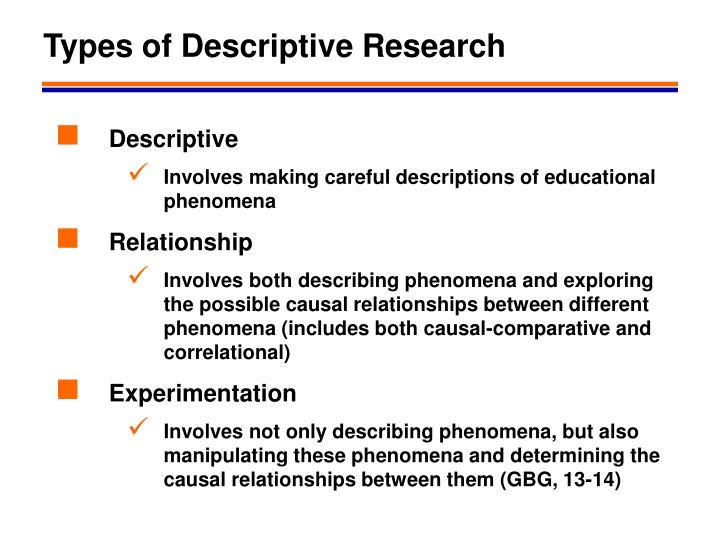Table Of Content

Finally, an explanation or justification of why a QD approach was chosen or appropriate for the study aims was not found in more than half of studies in the sample. Descriptive research methods can include surveys, observational studies, and case studies, and the data collected can be qualitative or quantitative. The findings from descriptive research provide valuable insights and inform future research, but do not establish cause-and-effect relationships. Moreover, our findings provide insights into the role of community TB prevention actors, currently functioning health system, and colleagues and other stakeholders’ regarding healthcare providers’ engagement. Participants emphasized that support from community TB prevention actors is a key motivation to effectively engage on management and prevention roles towards MDR-TB. Evidence shows that community TB prevention is one of the prominent interventions that study participants would expect in DOTS provision as community is the closest source of information regarding the patients [31, 32].
Use valid and reliable data collection methods

In addition, theauthors of three articles summarized, organized, and described their data using keyconcepts of conceptual models (Al-Zadjali et al.,2014; Oosterveld-Vlug et al., 2014; Wiens et al., 2014). Martorella et al. (2014) assessed acceptability and feasibility of hand massagetherapy and arranged their findings in relation to pre-determined indicators ofacceptability and feasibility. In another twostudies, the researchers described and compared themes or categories from two differentperspectives, such as patients and nurses (Canzan,Heilemann, Saiani, Mortari, & Ambrosi, 2014) or parents and children(Marcinowicz et al., 2014). Additionally, Ma(2014) reported themes using both participants’ language and theresearcher’s language.
Ensure adequate sample size
Following the identification of the 55 publications, two authors (HK and JS)independently examined each article using the Critical Appraisal Skills Programme (CASP)qualitative checklist (CASP, 2013). The CASP waschosen to determine the general adequacy (or rigor) of the qualitative studies included inthis review as the CASP criteria are generic and intend to be applied to qualitativestudies in general. With the next eightquestions, reviewers assess study design, sampling, data collection, and analysis as wellas the clarity of the study’s results statement and the value of the research. Weused the seven questions and 17 sub-questions related to methods and statement of findingsto evaluate the articles. Engagement of individual healthcare providers is one of the peculiar interventions to achieve the goal of universal access to drug resistance tuberculosis care and services [17].
Risk of sampling error
Your research design choices should be driven by your aims and priorities – start by thinking carefully about what you want to achieve. Descriptive research is an appropriate choice when the research aim is to identify characteristics, frequencies, trends, and categories. The authors did, subsequently in the paper, look at the relationship of myopia (an outcome) with children's age, gender, socioeconomic status, type of school, mother's education, etc. (each of which qualifies as an exposure). Those parts of the paper look at the relationship between different variables and thus qualify as having “analytical” cross-sectional design. Correlative surveys help establish if there is a positive, negative, or neutral connection between two variables.
Characteristics of Qualitative Descriptive Studies: A Systematic
Descriptive research design uses a range of both qualitative research and quantitative data (although quantitative research is the primary research method) to gather information to make accurate predictions about a particular problem or hypothesis. This involves examining the relationships between two or more variables to describe their patterns or associations. Correlational studies can be used to identify potential causal relationships or to explore the strength and direction of relationships between variables. Bereket Aberham Lajore, Yitagesu Habtu Aweke, and Samuel Yohannes Ayanto conceived the idea and wrote the proposal, participated in data management, analyzed the data and drafted the paper and revised the analysis and subsequent draft of the paper.
Second, only one database was searched andtherefore we did not identify or describe potential studies following a QD approach thatwere published in non-PubMed databases. Third, our review is limited by reliance on whatwas included in the published version of a study. In summary, our findings support the notion that many scholars employ QD andinclude a variety of commonly observed characteristics in their study design and subsequentpublications.
Completeness and consistency of primary outcome reporting in COVID-19 publications in the early pandemic phase: a ... - BMC Medical Research Methodology
Completeness and consistency of primary outcome reporting in COVID-19 publications in the early pandemic phase: a ....
Posted: Sat, 29 Jul 2023 07:00:00 GMT [source]
Descriptive phenomenological qualitative study design was employed between 02 May and 09 May, 2019. Verbatim transcripts were translated to English and exported to open code 4.02 for line-by-line coding and categorization of meanings into same emergent themes. Thematic analysis was conducted based on predefined themes for multidrug resistant tuberculosis prevention and management and core findings under each theme were supported by domain summaries in our final interpretation of the results. To maintain the rigors, Lincoln and Guba’s parallel quality criteria of trustworthiness was used particularly, credibility, dependability, transferability, confirmability and reflexivity. The study involved four focus group discussion (FGDs) and five key informants’ interview (KII) with a total of 26 participants to gather the necessary information. Expert purposive sampling technique was employed and sample size was determined based on the saturation of idea required during data collection process.
(PDF) AN INDISSOLUBLE QUESTION OF STEP UP OR DOWN: A DESCRIPTIVE ANALYSIS ON CHALLENGES ... - ResearchGate
(PDF) AN INDISSOLUBLE QUESTION OF STEP UP OR DOWN: A DESCRIPTIVE ANALYSIS ON CHALLENGES ....
Posted: Sat, 06 Apr 2024 16:34:56 GMT [source]
Sampling methods
Compare your paper to billions of pages and articles with Scribbr’s Turnitin-powered plagiarism checker. A clearly defined research question is the foundation of any research study, and it is important to ensure that the question is both specific and relevant to the topic being studied. Descriptive research findings may not be applicable to other populations or situations. The researcher’s own biases and preconceptions can influence the interpretation of the data. Descriptive research only provides a snapshot of the current situation and cannot establish cause-and-effect relationships.
To compare variables
The observational method is considered the most effective method for carrying out descriptive research. You can leverage offline survey tools to gather data digitally, even without the Internet. It focuses on generating ideas, hypotheses, or theories rather than providing definitive answers. Exploratory research is often conducted at the early stages of a research project to gather preliminary information and identify key variables or factors for further investigation.
As a result, improper sample transfer to Gene- Xpert sites and irregular postal delivery are frequent”. “Our; DOTS staff at the MDR-TB center, DOTS staff at the health center, and health extension workers are not well connected to one another. Many patients I encountered came to this center [MDR-TB center] after bypassing both health post and health center. The same holds true for medical facilities that are both public and private” (KII-P02). In my experience, the majority of newly graduated health professionals lack the required skill. I propose that pre-service education curricula to include TB/MDR-TB prevention and management guideline trainings” (KII-P01).
According to our discussion and interview, lack of health facility’s readiness takes paramount shares for the providers’ risk of exposures and their susceptibility. The research used a qualitative descriptive design with grounded theoryovertones (Sandelowski, 2000). In 26 articles (and not necessarily the same as those citing specific referencesto QD), researchers provided a rationale for selecting QD. Most researchers chose QDbecause this approach aims to produce a straight description and comprehensive summary ofthe phenomenon of interest using participants’ language and staying close to thedata (or using low inference). If you don’t have the time or resources to collect data from the population you’re interested in, you can also choose to use secondary data that other researchers already collected – for example, datasets from government surveys or previous studies on your topic. They often have similar approaches in terms of data collection, but focus on different aspects when analysing the data.
Research questions often begin with “What is …” These studies help find solutions to practical issues in social science, physical science, and education. This descriptive type of research employs surveys to collect information on various topics. This data aims to determine the degree to which certain conditions may be attained.
He uses a survey as his research instrument, and each item on the survey related to qualifications is subjected to a Yes/No answer. Descriptive research is a type of research that describes a population, situation, or phenomenon that is being studied. It focuses on answering the how, what, when, and where questions If a research problem, rather than the why.
You can further dissect descriptive research’s outcomes and use them for different types of investigation. The outcomes also serve as a foundation for subsequent investigations and can guide future studies. For example, you can use the data obtained in descriptive research to help determine future research designs. Besides making observations and then comparing and analyzing them, descriptive studies often develop knowledge concepts and provide solutions to critical issues. It always aims to answer how the event occurred, when it occurred, where it occurred, and what the problem or phenomenon is.
There may be instances when people provide false responses, compromising the validity of the data collected and the research results. A descriptive approach to research allows researchers to thoroughly investigate the background of a research problem before further research can be carried out. It can be used in social science research to explore and document the nature and scope of a problem, to identify trends and patterns, and to provide a basis for subsequent research. Descriptive research focuses on describing and summarizing data without making inferences or generalizations beyond the specific sample or population being studied.

No comments:
Post a Comment